🫥 Body Organisation
Learn aboutn basic body plane, it's features and body organistaion of Nematodes
Which of the following is correct regarding nematode?
Basic Features
- Even though nematodes occupy nearly every habitat on earth, they are remarkably similar in morphology and life stages. Despite their structural complexity, certain basic principles are common to all nematodes which could be defined as:
Nematodes are scientifically defined as aciliated, non-segmented, pseudocoelomic, bilaterally symmetrical, triploblastic, microscopic, vermiform metazoan of lower invertebrates having tissues assembled to form well developed organ system like digestive, reproductive, nervous system and poorly developed excretory system and lack respiratory and circulatory system having serpentine movement on the dorso-ventral plane and both sexes are present.
Aciliated
- Nematodes lack ciliated epithelium.

Non segmented
- Nematode body don’t have any segmentation or partition, but annulations or pseudo-partitions are present in some genera.

Pseudocoelomic
- Nematode body cavity is a false cavity filled with sterile cells.
- In case of true coelom, the body cavity is lined with epithelial or mesodermal lining which is absent in nematodes.
- Pseudocoelom is filled with a fluid in which other system remain suspended.
- In nematodes only ectoderm is lined with mesodermal layer while it is not lined to endoderm or alimentary canal of nematode.
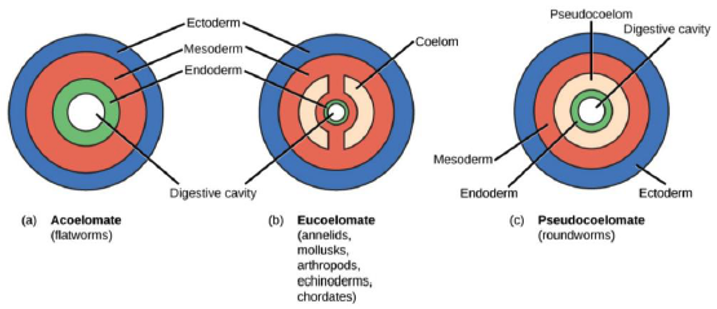
Bilaterally Symmetrical
- Nematode body shapes are
mirror imageof each other along a midline.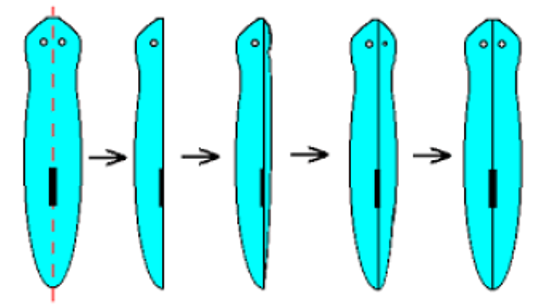
Triploblast
- Nematode body possess three germinal layer viz., ectoderm, mesoderm and endoderm.
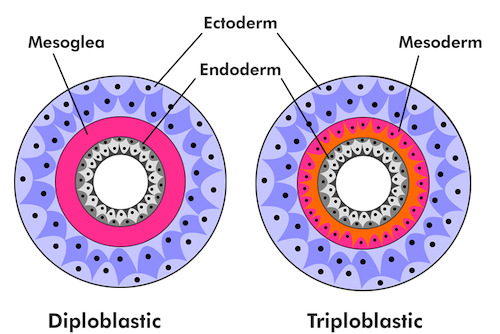
Vermiform
- Nematode body is long, slender, cylindrical shape tapering at both the ends.
Dorsoventral Plane
- Turgor pressure due to body fluid present inside the nematode body combined with elasticity helps the nematode to move in longitudinal axis in dorso ventral plane.

Body Organisation
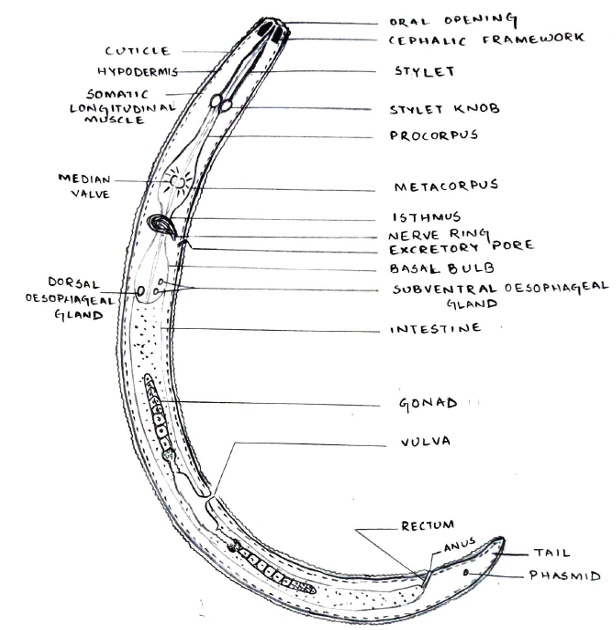
- Basically, the nematode body structure appears to be tubular consisting of two tubes (one tube within another tube).
- The outer tube is wider and larger and comprises of the body wall.
- Body wall constitutes the cuticle, epidermis or hypodermis and somatic longitudinal muscles.
- The inner body tube comparatively smaller and narrow lying within the outer body tube comprises of alimentary canal or gut or digestive system.
- Both the tube joint anteriorly forming the cephalic region which opens to oral opening or mouth opening or oral aperture.
- Posteriorly interconnected through rectum, which is opened to outside as anus in female, cloaca in male.
- Post anal or cloacal extension of nematode body towards posterior or terminal region comprises of tail.
- In between the two tubes the inner space being devoid of mesodermal epithelium around endodermis rather filled with pseudo coelomic fluid forming the pseudocoelom.
- On the pseudocoelom other organ systems like reproductive, nervous and secretory-excretory system remain suspended but there is lacking of respiratory and circulatory system.
- Function of respiration and circulation is carried out by the pseudocoelom.
- Longitudinally the entire nematode body structure is divisible into four sides or zones.
- The ventral side of the nematode body is first of all ascertained by the presence of natural openings like excretory pore, gonopore or vulva, anus or cloaca.
- Exactly opposite to the ventral side is the dorsal side which is devoid of any natural openings while observing the nematode under microscope.
- The front side the nematode body appears as one lateral and opposite to it another lateral side.
Body Shape
- Nematodes are usually vermiform, thread like.
- Both the sexes look alike but in respect to body shape certain nematodes genera male and juveniles differ from that of adult female.
- Morphological difference in the general shapes of male and females within a species is known as Sexual Dimorphism.
- Example:
- In case of sedentary nematodes, Root knot nematode (Meloidogyne spp.) adult female is
pyriformor saccate shape - Cyst nematode (Heterodera spp.) is
lemonshape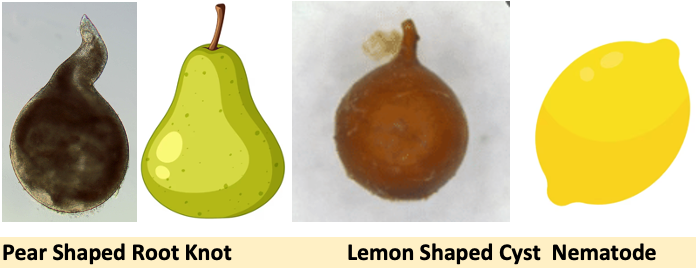
- In case of Semi-endoparasitic nematode, Citrus nematode (Tylenchulus spp.) adult female is
swollen or obese shape - Reniform nematode (Rotylenchulus spp.) shape is
kidney shape
- In case of sedentary nematodes, Root knot nematode (Meloidogyne spp.) adult female is
Body Size
- The length of the nematode may vary from 0.2 mm (Paratylenchus - Smallest Nematode) to about 11 mm (Paralongidorus maximus - longest Nematode).
- Their body width vary from
0.01 to 0.05 mm. - The largest nematode,
Placentonema gigantissimaparasite in the placenta of blue whale is about 8 m long. - Free-living and plant parasitic nematodes are usually microscopic in nature.
- Animal parasitic nematodes are larger in size as compared to free living and plant parasitic nematodes and visible to naked eyes.
Body Posture
- Generally, nematodes turn towards ventral side due to presence of natural openings. Like excretory pore, gonopore, anus/cloaca associated with the internal muscles that constrict the nematode body to turn towards the ventral side.
- There are certain genera of nematodes in which body posture is an identifying mark for differentiating nematode genera.
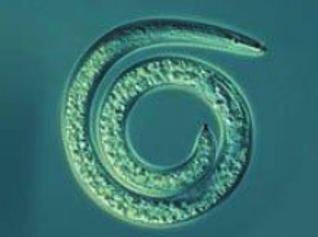
Spiral body of Helicotylenchus sp
- In case of Lesion nematode (Pratylenchus sp.) curved in ‘C’ shape.
- In case of
Dorsalla dorsata, even though the natural opening are present on the ventral side but still the nematode curvesdorsally.
Therefore we can say that mostly nematodes body curve towards ventral side except in case of Dorsella.
Body Symmetry
- Basically nematode body is bilaterally symmetrical i.e., mirror image of each other.
- But stylet knob and oesophageal glands shows
triradiate symmetrydue to presence of three stylet knob and glands respectively. - Lips have
Hexaradiate symmetry. The oral aperture is basically surrounded by six lips known as hexaradial symmetry.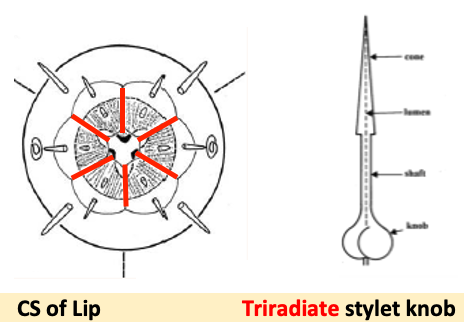
Body Colour
- Nematodes are generally colourless or slight yellowish tint depending upon the chemical composition of cuticle.
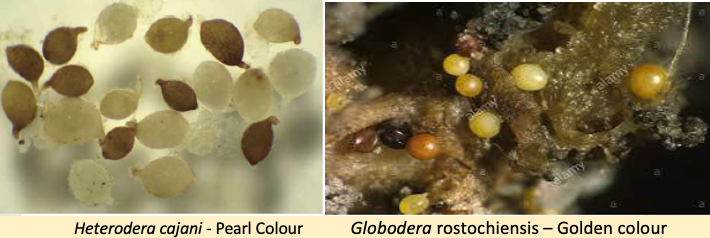
References
- Dasgupta, M. K. (1998). Phytonematology. Nayaprakash, Calcutta.
- Walia, R. K and Bajaj, H. K (2014). Textbook of Introductory Plant Nematology. Directorate of Knowledge Management in Agriculture, ICAR, New Delhi.
- Ravichandra, N. G. (2019). Plant Nematology. I. K. International Publishing House Pvt. Ltd., New Delhi.
- Dropkin, V. H. (1996). Introduction to Plant Nematology, Academic Press, New York.
Which of the following is correct regarding nematode?
Basic Features
- Even though nematodes occupy nearly every habitat on earth, they are remarkably similar in morphology and life stages. Despite their structural complexity, certain basic principles are common to all nematodes which could be defined as:
Nematodes are scientifically defined as aciliated, non-segmented, pseudocoelomic, bilaterally symmetrical, triploblastic, microscopic, vermiform metazoan of lower invertebrates having tissues assembled to form well developed organ system like digestive, reproductive, nervous system and poorly developed excretory system and lack respiratory and circulatory system having serpentine movement on the dorso-ventral plane and both sexes are present.
Aciliated
- Nematodes lack ciliated …
Become Successful With AgriDots
Learn the essential skills for getting a seat in the Exam with
🦄 You are a pro member!
Only use this page if purchasing a gift or enterprise account
Plan
- Unlimited access to PRO courses
- Quizzes with hand-picked meme prizes
- Invite to private Discord chat
- Free Sticker emailed
Lifetime
- All PRO-tier benefits
- Single payment, lifetime access
- 4,200 bonus xp points
- Next Level
T-shirt shipped worldwide

Yo! You just found a 20% discount using 👉 EASTEREGG

High-quality fitted cotton shirt produced by Next Level Apparel